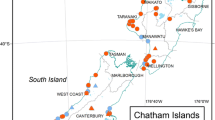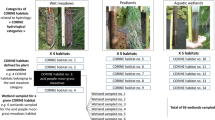Abstract
We measured soil organic matter (SOM) concentrations in a large sample (n=95) of freshwater emergent and open water wetlands in the Portland, Oregon, USA, area as part of a study of the ecological development of mitigation wetlands. Mean SOM concentrations were higher in naturally occurring wetlands (NOWs) than in mitigation wetlands (MWs) at 0–5 cm (SOM=9.75 and 5.83%, respectively, p=0.0001) and at 15–20 cm (SOM=6.85, 4.68%, p=0.0551). If temporal accumulation of SOM is occurring, it is slow; we found no significant relationship between SOM and wetland age (p=0.6003) and no significant change in SOM concentration in soils in MWs sampled in 1987 and 1993. Concentrations of SOM were not significantly related to land use but were related to soil series, texture class, and association, and to hydrogeomorphic class. For a subset of wetlands monitored for hydrology, we also found a significant negative relationship between SOM and the extent of inundation by standing water. Mitigation may be leading to direct loss of SOM, probably resulting from soil management practices during project construction. We also show that hydrologic regime significantly affects SOM. Because most projects in our study were built in pre-existing wetlands and have extensive areas of open water, our results suggest that low concentrations of SOM are likely to persist. For SOM and probably for SOM-supported wetland functions, fundamental goals of mitigation and wetland management (in-kind wetland replacement, no-net-loss of structure and function) are not being achieved, at least in the short term. The success of mitigation, in terms of SOM, could be improved by better project design and better management of soils during project construction.
Similar content being viewed by others
Literature Cited
Bishel-Machung, L., R. P. Brooks, S. S. Yates, and K. L. Hoover. 1996. Soil properties of reference wetlands and wetland creation projects in Pennsylvania. Wetlands 16:532–541.
Blume, L. J., B. A. Schumacher, P. W. Shaffer, K. A. Cappo, M. L. Papp, R. D. van Remortel, D. S. Coffey, M. G. Johnson, and D. Chaloud. 1990. Handbook of Methods for Acid Deposition Studies: Laboratory Analyses for Soil Chemistry. U.S. Environmental Protection Agency, Office of Research and Development, Washington, DC, USA. EPA/600/4-90/058.
Brinson, M. M. 1993. A Hydrogeomorphic Classification for Wetlands. U.S. Army Corps of Engineers, Waterways Experiment Station, Vicksburg, MS, USA. Technical Report WRP-DE-4.
Clarke, S. E., D. White, and A. L. Schaedel, 1991. Oregon ecological regions and subregions for water quality management. Environmental Management 15:847–856.
Confer, S. R. and W. A. Niering. 1992. Comparison of created and natural freshwater emergent wetlands in Connecticut (USA). Wetlands Ecology and Management 2:143–156.
The Conservation Foundation. 1988. Protecting America’s Wetlands: An Action Agenda. Final Report of the National Wetlands Policy Forum. The Conservation Foundation, Washington, DC, USA.
Cowardin, L. M., V. Carter, F. C. Golet, and E. T. LaRue. 1979. Classification of Wetlands and Deepwater Habitats of the United States. U.S. Fish and Wildlife Service, Washington, DC, USA. FWS/OBS-79-31.
Craft, C. B., S. W. Broome, and E. D. Seneca. 1988. Nitrogen, phosphorus, and organic carbon pools in natural and transplanted marsh soils. Estuaries 11:272–280.
Davis, M. M. 1995. Endemic Wetlands of the Willamette Valley, Oregon. p. 1–8.In Studies of Plant Establishment Limitations in Wetlands of the Willamette Valley, Oregon. U.S. Army Corps of Engineers, Waterways Experiment Station, Vicksburg, MS, USA. Technical Report WRP-RE-13.
Day, F. P., Jr. and J. P. Megonigal. 1993. The relationship between variable hydroperiod, production allocation, and below ground organic turnover in forested wetlands. Wetlands 13:115–121.
Duncan, C. P. and P. M. Groffman. 1994. Comparing microbial parameters in natural and constructed wetlands. Journal of Environmental Quality 23:298–305.
Dwire, K. A., P. W. Shaffer, S. E. Gwin, T. K. Magee, J. Honea, R. G. Gibson, and T. Ernst. 1997. Quality Assurance Report for the Oregon Wetlands Study. U.S. Environmental Protection Agency, National Health and Environmental Effects Research Laboratory—Western Ecology Division, Corvallis, OR, USA. EPA/600/R-97.
Erwin, K. L. 1991. An evaluation of mitigation in the South Florida Water Management District, Volume 1. South Florida Water Management District, West Palm Beach, FL, USA.
Gerig, A. J. 1985. Soil Survey of Clackamas County, Oregon. USDA Soil Conservation Service, Oregon Agricultural Experiment Station, Corvallis, OR, USA.
Gibson, K. D., J. B. Zedler, and R. Langis. 1994. Limited response of cordgrass (Spartina foliosa) to soil amendments in a constructed marsh. Ecological Applications 4:757–767.
Gosselink, J. G. and R. E. Turner. 1978. the role of hydrology in freshwater wetland ecosystems. p. 63–78.In R. E. Good, D. F. Whigham, and R. L. Simpson (eds.) Freshwater Wetlands: Ecological Processes and Management Potential. Academic Press, New York, NY, USA.
Green, G. L. 1982. Soil Survey of Washington County, Oregon. USDA Soil Conservation Service, Oregon Agricultural Experiment Station, Corvallis, OR, USA.
Green, G. L. 1983. Soil Survey of Multnomah County, Oregon. USDA Soil Conservation Service, Oregon Agricultural Experiment Station, Corvallis, OR, USA.
Groffman, P. M., G. C. Hanson, E. Kiviat, and G. Stevens. 1996. Variation in microbial biomass and activity in four different wetland types. Soil Science Society of America Journal 60:622–629.
Guard, B. J. 1995. Wetland Plants of Oregon and Washington. Lone Pine Publishing, Redmond, WA, USA.
Gwin, S. E., M. E. Kentula, and P. W. Shaffer. 1999. Evaluating the effects of wetland regulation through hydrogeomorphic classification and landscape profiles. Wetlands 19:(477–489).
Holland, C. C., J. E. Honea, S. E. Gwin, and M. E. Kentula. 1995. Wetland degradation and loss in the rapidly urbanizing area of Portland, Oregon, Wetlands 15:336–345.
Kantrud, H. A., J. B. Millar, and A. G. van der Valk. 1989. Vegetation of wetlands of the Prairie Pothole Region. p. 132–187.In A. G. van der Valk (ed.) Northern Prairie Wetlands, Iowa State University Press, Ames, IA, USA.
Kentula, M. E., R. E. Brooks, S. E. Gwin, C. C. Holland, A. D. Sherman, and J. C. Sifneos. 1992a. An Approach to Decision Making in Wetland Creation and Restoration. U.S. Environmental Protection Agency, Environmental Research Laboratory, Corvallis, OR, USA. EPA/600/R-92/150.
Kentula, M. E., J. C. Sifneos, J. W. Good, M. Rylko, and K. Kunz. 1992b. Trends and patterns in Section 404 permitting requiring compensatory mitigation in Oregon and Washington. Environmental Management 16:109–119.
Kusler, J. A. and M. E. Kentula. 1990. Executive Summary. p. xvii-xxv.In J. A. Kusler and M. E. Kentula (eds.) Wetland Creation and Restoration: The Status of the Science. Island Press, Washington, DC, USA.
Langis, R., M. Zalejko, and J. B. Zedler. 1991. Nitrogen assessments in a constructed and a natural salt marsh of San Diego Bay. Ecological Applications 1:40–51.
Lathwell, D. J., H. F. Mulligan, and D. R. Bouldin. 1969. Chemical properties, physical properties, and plant growth in twenty artificial wildlife marshes. New York Fish and Game Journal 16:158–183.
Lindau, C. W. and L. R. Hossner. 1981. Substrate characterization of an experimental marsh and three natural marshes. Soil Science Society of America Journal 45:1171–1176.
Magee, T. K., S. E. Gwin, R. G. Gibson, C. C. Holland, I. Honea, P. W. Shaffer, J. C. Sifneos, and M. E. Kentula. 1993. Research Plan and Field Manual for the Oregon Wetlands Study. U.S. Environmental Protection Agency, Environmental Research Laboratory, Corvallis, OR, USA. EPA/600/R-93/072.
McVoy, G. R. 1988. Advantages of open water/emergent wetlands for mitigation and a holistic approach to banking. p. 289–290.In J. A. Kusler, M. L. Quammen, and G. Brooks (eds.) Mitigation of Impacts and Losses. Association of State Wetland Managers. Berne, NY, USA.
Middleton, B. A. 1995. Seed banks and species richness potential of coal slurry ponds reclaimed as wetlands. Restoration Ecology 3:311–318.
Minello, T. J. and J. W. Webb, Jr. 1997. Use of natural and createdSpartina alterniflora salt marshes by fishery species and other aquatic fauna in Galveston Bay, Texas, USA. Marine Ecology Progress Series 151:165–179.
Mitsch, W. J. and J. G. Gosselink. 1993. Wetlands, second edition. Van Nostrand Reinhold Company, New York, NY, USA.
Morris, J. T. and W. B. Bowden. 1986. A mechanistic, numerical model of sedimentation, mineralization, and decomposition for marsh sediments. Soil Science Society of America Journal 50:96–105.
Moy, L. D. and L. A. Levin. 1991. AreSpartina marshes a replaceable resource? A functional approach to evaluation of marsh creation efforts. Estuaries 14:1–16.
NRC (National Research Council, USA). 1992. Restoration of Aquatic Ecosystems: Science, Technology, and Public Policy, National Academy Press, Washington, DC, USA.
ODLCD. 1992. What is an Urban Growth Boundary? Oregon Department of Land Conservation and Development. Salem, OR, USA.
Omernik, J. M. 1988. Ecoregions of the conterminous United States. Annals of Association of American Geographers 77:118–125.
Paul, E. A. and F. E. Clark. 1989. Soil Microbiology and Biochemistry. Academic Press, Inc., San Diego, CA, USA.
Race, M. S. and M. S. Fonseca. 1996. Fixing compensatory mitigation: What will it take? Ecological Applications 6:94–101.
Sacco, J. N., E. D. Seneca, and T. R. Wentworth. 1994. Infaunal community development of artificially established salt marshes in North Carolina. Estuaries 17:489–500.
Scatolini, S. R. and J. B. Zedler. 1996. Epibenthic invertebrates of natural and constructed marshes of San Diego Bay. Wetlands 16:24–37.
Shaffer, P. W., M. E. Kentula, and S. E. Gwin. 1999. Characterization of wetland hydrology using hydrogeomorphic classification. Wetlands 19:(490–504).
Simenstad, C. A. and R. M. Thom. 1996. Functional equivalency trajectories of the restored Gog-Le-Hi-Te estuarine wetland. Ecological Applications 6:38–56.
Smith, R. D., A. Ammann, C. Bartoldus, and M. M. Brinson, 1995. An Approach for Assessing Wetland Functions Using Hydrogeomorphic Classification, Reference Wetlands, and Functional Indices. U.S. Army Corps of Engineers, Waterways Experiment Station, Vicksburg, MS, USA. Technical Report WRP-DE-9.
Spencer, H. E., Jr. 1963. Man-made Marshes for Maine Waterfowl. Maine Department of Inland Fisheries and Game. Augusta, ME, USA. Game Division Bulletin # 9.
Steel, R. G. B. and J. H. Torrie. 1980. Principles and Procedures of Statistics: A Biometrical Approach. McGraw-Hill Book Co., New York, NY, USA.
U.S. Department of Agriculture, Soil Conservation Service. 1984. Procedures for Collecting Soil Samples and Methods of Analysis for Soil Survey. U.S. Government Printing Office. Washington, DC, USA. Soil Survey Investigations Report No. 1.
van der Valk, A. G. and C. B. Davis. 1978. The role of seed banks in the vegetation dynamies of prairie glacial marshes. Ecology 59:322–335.
Wetzel, R. G. 1983. Limnology. Saunders College Publishing Co., Philadelphia, PA, USA.
Zedler, J. B. and R. Langis. 1991. Comparisons of constructed and natural salt marshes of San Diego Bay. Restoration and Management Notes 9:21–25.
Author information
Authors and Affiliations
Corresponding author
Rights and permissions
About this article
Cite this article
Shaffer, P.W., Ernst, T.L. Distribution of soil organic matter in freshwater emergent/open water wetlands in the Portland, Oregon metropolitan area. Wetlands 19, 505–516 (1999). https://doi.org/10.1007/BF03161689
Received:
Revised:
Accepted:
Issue Date:
DOI: https://doi.org/10.1007/BF03161689




